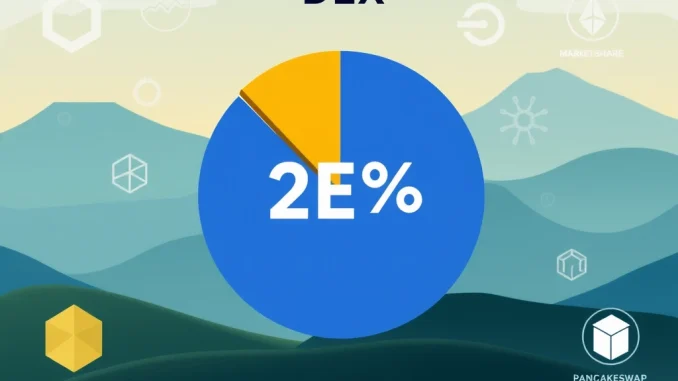
The world of cryptocurrency trading is witnessing a significant transformation. Recent data reveals that Decentralized exchanges (DEXs) have reached a major milestone, capturing a substantial portion of the global market. This surge in activity is changing how participants interact with digital assets, moving towards more autonomous platforms.
Understanding the Surge in DEX Market Share
May 2024 marked a pivotal moment for decentralized exchanges. According to data from The Block, DEXs achieved their highest-ever share of the global spot trading volume, reaching an impressive 25%. This figure represents a significant shift from previous months and years, indicating growing user confidence and preference for decentralized platforms.
Key figures from May’s performance:
- Total Crypto trading volume on DEXs: $410.2 billion
- Leading platform: PancakeSwap ($171.6 billion volume)
- Other significant contributors: Aerodrome and PumpSwap (each near $15 billion volume)
This data underscores the increasing liquidity and activity flowing into the decentralized finance (DeFi) ecosystem.
Why the Shift to Decentralized Exchanges?
The move towards DEXs reflects a broader philosophical shift within the crypto space. As Simon Kim, CEO of Hashed, noted, it signifies a transition from centralized, trust-based systems (like traditional centralized exchanges or CEXs) to decentralized, code-driven trading environments. This shift is often driven by factors such as:
- Increased user control over private keys and assets.
- Reduced counterparty risk compared to holding funds on a CEX.
- Access to a wider range of tokens, particularly newer or smaller projects.
- Transparency of transactions on the blockchain.
While CEXs still dominate the market, the rapid growth of DEXs suggests that a significant segment of traders values the principles of decentralization and self-custody.
Looking Ahead: CEX vs DEX Dynamics
The debate between centralized and decentralized exchanges is ongoing. Simon Kim’s forecast paints a bold picture for the future, predicting that DEXs could surpass CEXs in trading volume by 2028 and become the leading model for crypto trading by 2030. This prediction, while ambitious, highlights the perceived trajectory of the decentralized finance space.
Factors that could influence this trend include:
- Ongoing regulatory developments impacting both CEXs and DEXs.
- Improvements in DEX user experience, speed, and cost (e.g., layer 2 scaling solutions).
- Increased institutional adoption of DeFi protocols.
- Further innovation in DEX models and liquidity provision.
Platforms like PancakeSwap, with its massive PancakeSwap volume contributing significantly to the overall DEX market share, are at the forefront of this evolution.
Conclusion: A New Era for Crypto Trading Volume
The record 25% DEX market share in May is more than just a statistic; it’s a clear signal of the growing maturity and adoption of decentralized trading platforms. While challenges remain, the trend towards code-driven, user-controlled trading is undeniable. The coming years will be crucial in determining whether decentralized exchanges can maintain this momentum and potentially reshape the landscape of global crypto trading as predicted.



